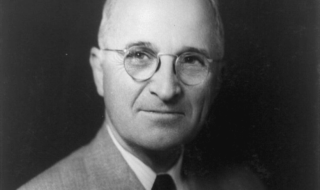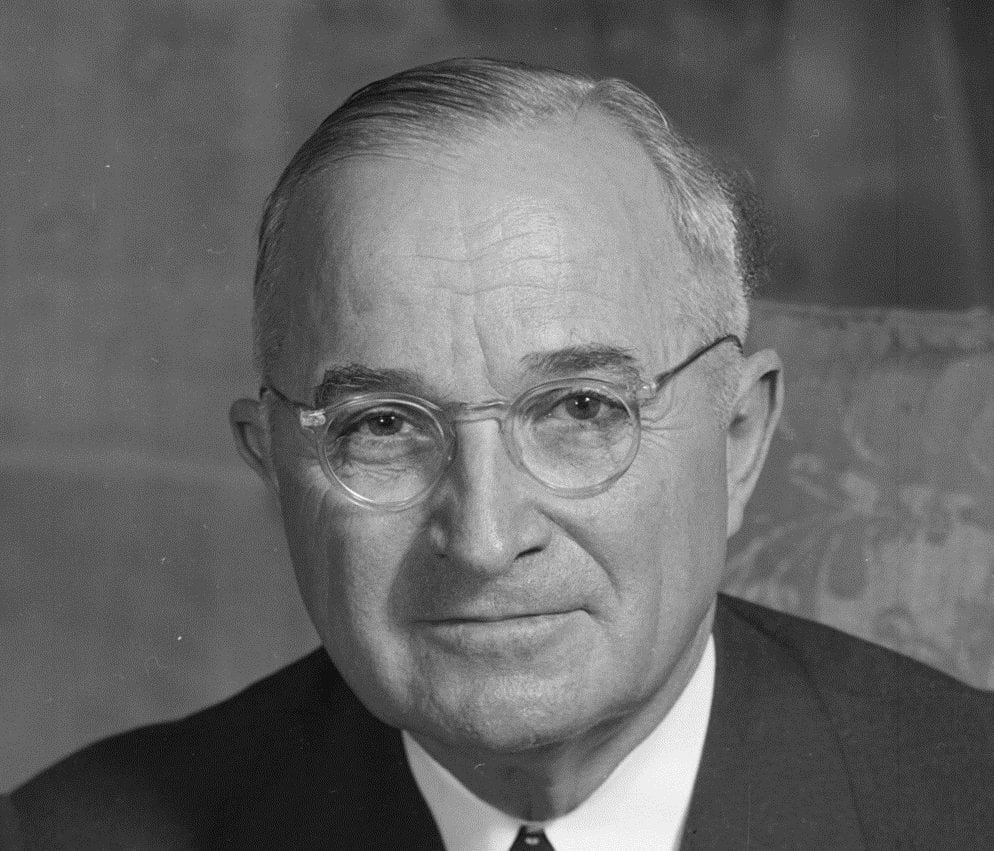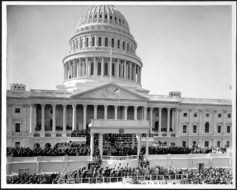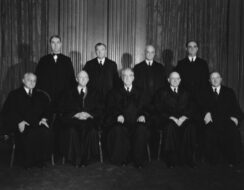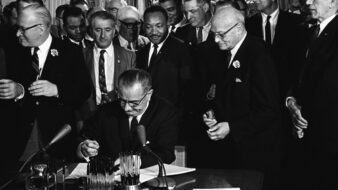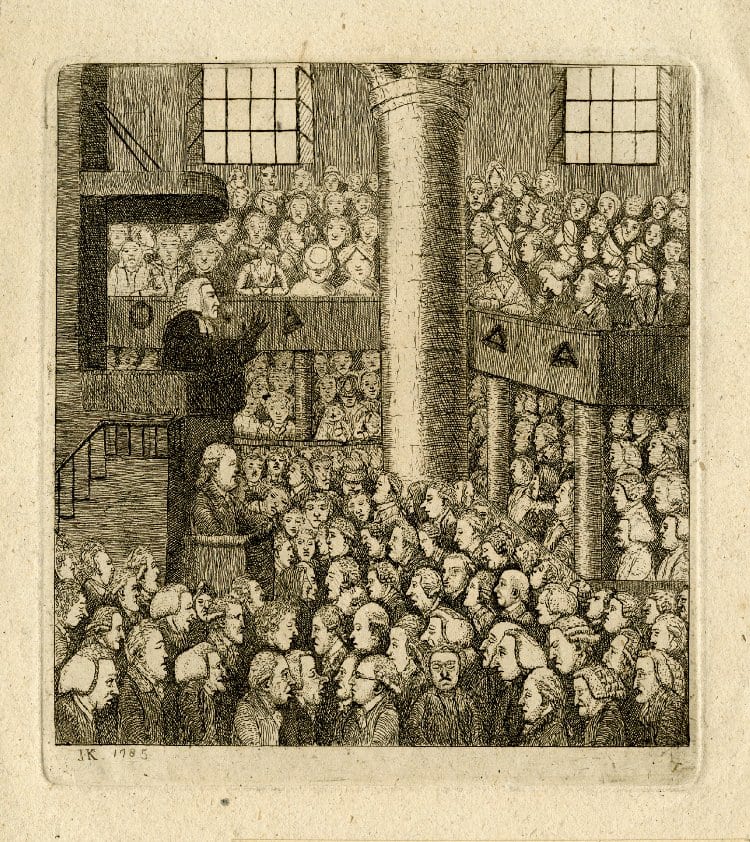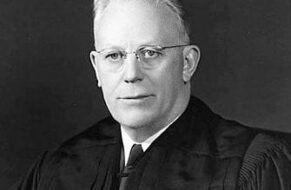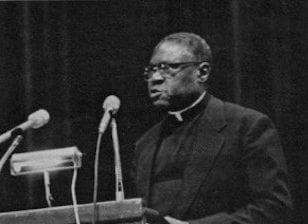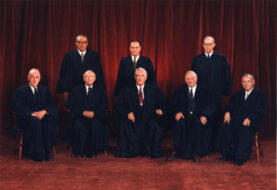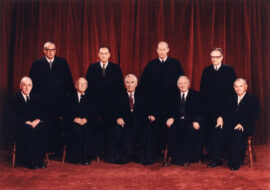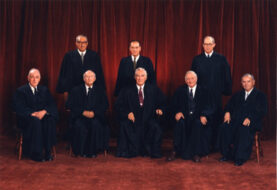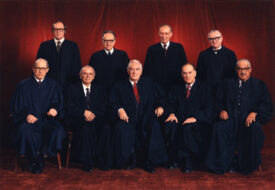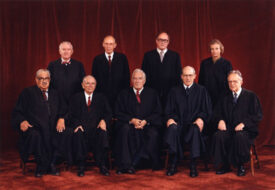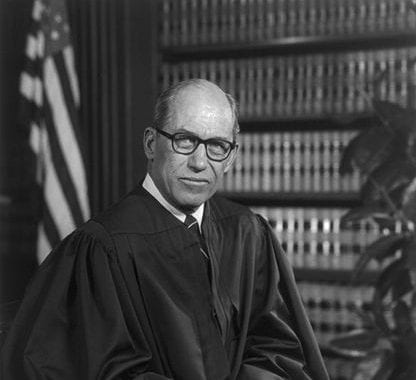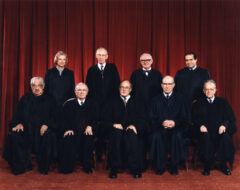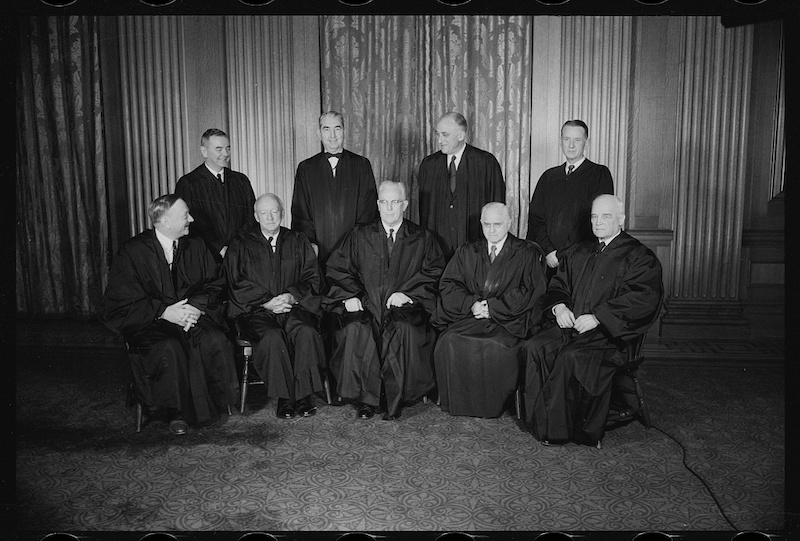
No related resources
Introduction
Following the Supreme Court’s decision in Brown v. Board of Education (1954) overturning Plessy (1896) as it applied to K–12 education, many southern states and school districts adopted a posture of “massive resistance.” The Little Rock, Arkansas, School Board drafted a plan to desegregate its schools, but the governor and legislature of Arkansas continued to defy the Court’s desegregation decision, going so far as to amend the state’s constitution to command the Arkansas legislature to resist “the unconstitutional decisions” of Brown. When nine African American students attempted to integrate Central High School in Little Rock in 1957, a crisis ensued, eventually requiring the presence of federal troops to restore order. In response to federal court orders derived from Brown, members of the school board in Little Rock filed suit requesting that African American children be resegregated into their previous schools and for the desegregation plan to be delayed. They justified their request based on the “chaos, bedlam, and turmoil” that occurred after the integration of Central High School. The District Court approved their request, but the U.S. Court of Appeals for the Eighth Circuit reversed it. The question before the Supreme Court in Cooper v. Aaron was whether state government officials were bound by federal court decisions. The Court unanimously upheld the Eighth Circuit.
The true significance of Cooper v. Aaron lies in how the Court justified its decision. For the first time, the Court declared itself the supreme interpreter of the Constitution. The Court’s unanimous, signed per curiam opinion, which was largely written by Justice Brennan (1906—1997), incorrectly said that Marbury v. Madison “declared the basic principle that the federal judiciary is supreme in the exposition of the law of the Constitution.” Further, it said that the Court’s interpretation of the Constitution “is the supreme law of the land.” Although Brennan was the principal author, the Court took the unusual step of issuing a signed per curiam decision, a decision that does not identify a specific judge as author, because the Court wanted to send a signal to the nation of its unity on Brown v. Board of Education.
The implication of this reasoning is even more consequential since it implies that the Court’s interpretations are universally binding on everyone, not just the parties to the case—another novel claim the Court had not made before. This, in turn, raised one fundamental, and troubling, question. If the Court’s interpretation of the Constitution is the supreme law of the land, does that not necessarily imply that the Court is claiming to be above the Constitution itself? Since Cooper, the Court has routinely reiterated its claim to be the final arbiter, but it is not clear that it has ever adequately addressed this concern.
Source: 358 U.S. 1, https://www.law.cornell.edu/supremecourt/text/358/1.
Opinion of the Court by THE CHIEF JUSTICE, MR. JUSTICE BLACK, MR. JUSTICE FRANKFURTER, MR. JUSTICE DOUGLAS, MR. JUSTICE BURTON, MR. JUSTICE CLARK, MR. JUSTICE HARLAN, MR. JUSTICE BRENNAN, and MR. JUSTICE WHITTAKER.
As this case reaches us, it raises questions of the highest importance to the maintenance of our federal system of government. It necessarily involves a claim by the governor and legislature of a state that there is no duty on state officials to obey federal court orders resting on this Court’s considered interpretation of the United States Constitution. Specifically, it involves actions by the governor and legislature of Arkansas upon the premise that they are not bound by our holding in Brown v. Board of Education. That holding was that the Fourteenth Amendment forbids states to use their governmental powers to bar children on racial grounds from attending schools where there is state participation through any arrangement, management, funds, or property. We are urged to uphold a suspension of the Little Rock School Board’s plan to do away with segregated public schools in Little Rock until state laws and efforts to upset and nullify our holding in Brown v. Board of Education have been further challenged and tested in the courts. We reject these contentions. . . .
[In reaching our decision,] we have accepted without reservation the position of the School Board, the Superintendent of Schools, and their counsel that they displayed entire good faith in the conduct of these proceedings and in dealing with the unfortunate and distressing sequence of events which has been outlined. We likewise have accepted the findings of the District Court as to the conditions at Central High School during the 1957–1958 school year, and also the findings that the educational progress of all the students, white and colored, of that school has suffered, and will continue to suffer if the conditions which prevailed last year are permitted to continue.
The significance of these findings, however, is to be considered in light of the fact, indisputably revealed by the record before us, that the conditions they depict are directly traceable to the actions of legislators and executive officials of the state of Arkansas, taken in their official capacities, which reflect their own determination to resist this Court’s decision in the Brown case and which have brought about violent resistance to that decision in Arkansas. In its petition for certiorari1 filed in this Court, the School Board itself describes the situation in this language: “The legislative, executive, and judicial departments of the state government opposed the desegregation of Little Rock schools by enacting laws, calling out troops, making statements villifying federal law and federal courts, and failing to utilize state law enforcement agencies and judicial processes to maintain public peace.”
One may well sympathize with the position of the board in the face of the frustrating conditions which have confronted it, but, regardless of the board’s good faith, the actions of the other state agencies responsible for those conditions compel us to reject the board’s legal position. Had Central High School been under the direct management of the state itself, it could hardly be suggested that those immediately in charge of the school should be heard to assert their own good faith as a legal excuse for delay in implementing the constitutional rights of these respondents, when vindication of those rights was rendered difficult or impossible by the actions of other state officials. The situation here is in no different posture because the members of the School Board and the Superintendent of Schools are local officials; from the point of view of the Fourteenth Amendment, they stand in this litigation as the agents of the state.
The constitutional rights of respondents2 are not to be sacrificed or yielded to the violence and disorder which have followed upon the actions of the governor and legislature. . . .
The controlling legal principles are plain. The command of the Fourteenth Amendment is that no “state” shall deny to any person within its jurisdiction the equal protection of the laws. “A state acts by its legislative, its executive, or its judicial authorities. It can act in no other way. The constitutional provision, therefore, must mean that no agency of the state, or of the officers or agents by whom its powers are exerted, shall deny to any person within its jurisdiction the equal protection of the laws. Whoever, by virtue of public position under a state government, . . . denies or takes away the equal protection of the laws violates the constitutional inhibition; and, as he acts in the name and for the state, and is clothed with the state’s power, his act is that of the state. This must be so, or the constitutional prohibition has no meaning.”3 Thus, the prohibitions of the Fourteenth Amendment extend to all action of the state denying equal protection of the laws; whatever the agency of the state taking the action, or whatever the guise in which it is taken. In short, the constitutional rights of children not to be discriminated against in school admission on grounds of race or color declared by this Court in the Brown case can neither be nullified openly and directly by state legislators or state executive or judicial officers nor nullified indirectly by them through evasive schemes for segregation whether attempted “ingeniously or ingenuously.”
What has been said, in the light of the facts developed, is enough to dispose of the case. However, we should answer the premise of the actions of the governor and legislature that they are not bound by our holding in the Brown case. It is necessary only to recall some basic constitutional propositions which are settled doctrine.
Article VI of the Constitution makes the Constitution the “supreme Law of the Land.” In 1803, Chief Justice Marshall, speaking for a unanimous Court, referring to the Constitution as “the fundamental and paramount law of the nation,” declared in the notable case of Marbury v. Madison,4 “It is emphatically the province and duty of the judicial department to say what the law is.” This decision declared the basic principle that the federal judiciary is supreme in the exposition of the law of the Constitution, and that principle has ever since been respected by this Court and the country as a permanent and indispensable feature of our constitutional system. It follows that the interpretation of the Fourteenth Amendment enunciated by this Court in the Brown case is the supreme law of the land, and Art. VI of the Constitution makes it of binding effect on the states “any Thing in the Constitution or Laws of any State to the Contrary notwithstanding.” Every state legislator and executive and judicial officer is solemnly committed by oath taken pursuant to Art. VI, cl. 3 “to support this Constitution.”
No state legislator or executive or judicial officer can war against the Constitution without violating his undertaking to support it. Chief Justice Marshall spoke for a unanimous Court in saying that: “If the legislatures of the several states may at will, annul the judgments of the courts of the United States, and destroy the rights acquired under those judgments, the Constitution itself becomes a solemn mockery. . . .”5 A governor who asserts a power to nullify a federal court order is similarly restrained. If he had such power, said Chief Justice Hughes, in 1932, also for a unanimous Court, “it is manifest that the fiat of a state governor, and not the Constitution of the United States, would be the supreme law of the land; that the restrictions of the federal Constitution upon the exercise of state power would be but impotent phrases. . . .”6
It is, of course, quite true that the responsibility for public education is primarily the concern of the states, but it is equally true that such responsibilities, like all other state activity, must be exercised consistently with federal constitutional requirements as they apply to state action. The Constitution created a government dedicated to equal justice under law. The Fourteenth Amendment embodied and emphasized that ideal. State support of segregated schools through any arrangement, management, funds, or property cannot be squared with the amendment’s command that no state shall deny to any person within its jurisdiction the equal protection of the laws. The right of a student not to be segregated on racial grounds in schools so maintained is indeed so fundamental and pervasive that it is embraced in the concept of due process of law. The basic decision in Brown was unanimously reached by this Court only after the case had been briefed and twice argued and the issues had been given the most serious consideration. Since the first Brown opinion, three new justices have come to the Court. They are at one with the justices still on the Court who participated in that basic decision as to its correctness, and that decision is now unanimously reaffirmed. The principles announced in that decision and the obedience of the states to them, according to the command of the Constitution, are indispensable for the protection of the freedoms guaranteed by our fundamental charter for all of us. Our constitutional ideal of equal justice under law is thus made a living truth. . . .
- 1. A writ or order by which a higher court reviews a decision of a lower court.
- 2. Respondents are defendants in a lawsuit.
- 3. Ex parte Virginia, 100 U.S. 339 347, 25 L.Ed. 676 (1879).
- 4. Marbury v. Madison
- 5. Chief Justice John Marshall (1755–1835) writing in United States v. Peters, 9 U.S. 5 Cranch 115 115 (1809).
- 6. Chief Justice Charles Evans Hughes (1862–1948) writing in Sterling v. Constantin, 287 U.S. 378 (1932).
The Kitchen Debate
July 25, 1959
Conversation-based seminars for collegial PD, one-day and multi-day seminars, graduate credit seminars (MA degree), online and in-person.






